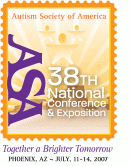 |
The ASA's 38th National Conference on Autism Spectrum Disorders (July 11-14, 2007) of ASAThe Westin Kierland Resort & Spa, Scottsdale, AZ |
| For a complete author index with session numbers, please click here | |
| Thursday, July 12, 2007: 10:45 AM-12:00 PM | |||
| Rainmakers Ballroom B | |||
| #2906- Augmentative/Alternative Communication for Individuals with Autism: System Selection & Implementation Issues-BCBA Session/ASHA CEU Session* | |||
| With the statistics of mutism for the autism population ranging from
35 to 50 percent, the need to provide effective augmentative/ alternative communication
system for individuals with autism must be a priority. At the present time in the field of
autism service delivery, there appears to be some misguided opinion that “one size” fits
all in regards to AAC for individuals with autism. AAC decision making must be
systematic and individualized. This workshop will focus on the key issues in AAC
system selection and implementations.
| |||
| Presenter: | - Anne Holmes is Chief Clinical Officer for The Eden Family of Services. She is an adjunct faculty member of the College of New Jersey, and is on the Autism Society Panel of Professional Advisors. Ms. Holmes has written numerous papers and articles and is the primary editor of Eden’s curriculum. | ||
|
| |||
| Abstract: “Effective communication is essential to the quality of life for all human beings.” This powerful statement made by the American Speech and Hearing Association in 1991 clearly demonstrates the importance of providing every individual with autism an effective communication system. With the statistics of mutism for the autism population ranging from 35 to 50% the need to provide effective augmentative/alternative communication systems for individuals with autism has to be a priority. The use of AAC in general has seen rapid growth since the 1990's. This is due to the technology explosion as well as the mandates in I.D.E.A. and A.D.A. Although research is limited, best practices clearly demonstrates the effectiveness of augmentative/alternative communication for individuals with autism. At the present time, in the field of autism service delivery, there appears to be some misguided opinion that “one size fits all” in regard to AAC systems for individuals with autism. Due to the varied nature of autism spectrum disorder, individualization of system selection is essential. The AAC systems to be considered include: gesture systems, sign language, object boards, picture boards, picture exchange communication systems, and voice output devices. Clinicians who specialize in serving individuals with autism must focus on matching the communication user to a specific system. This is an individualized process that looks at the communication needs of the individual with autism, their overall cognitive, language, and social skill levels, motor skills, the environment in which they communicate, and their motivation to communicate. Another important area of focus when designing and implementing an AAC system for an individual with autism is to assess and eliminate barriers to successful use of such a system. The global barriers fall into the categories of opportunity barriers and access barriers. This workshop will focus on the key issues in system selection and then how, once a system has been selected, it can be successfully implemented in the environment of that individual with autism. | |||
See more of General Submissions
See more of The ASA's 38th National Conference on Autism Spectrum Disorders (July 11-14, 2007)